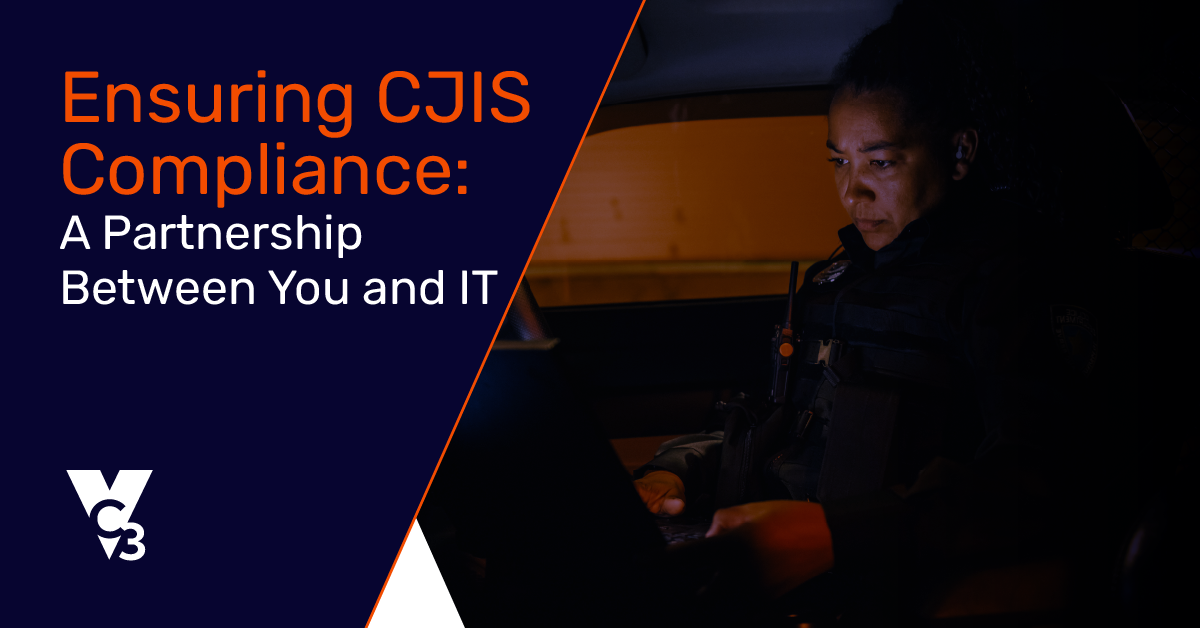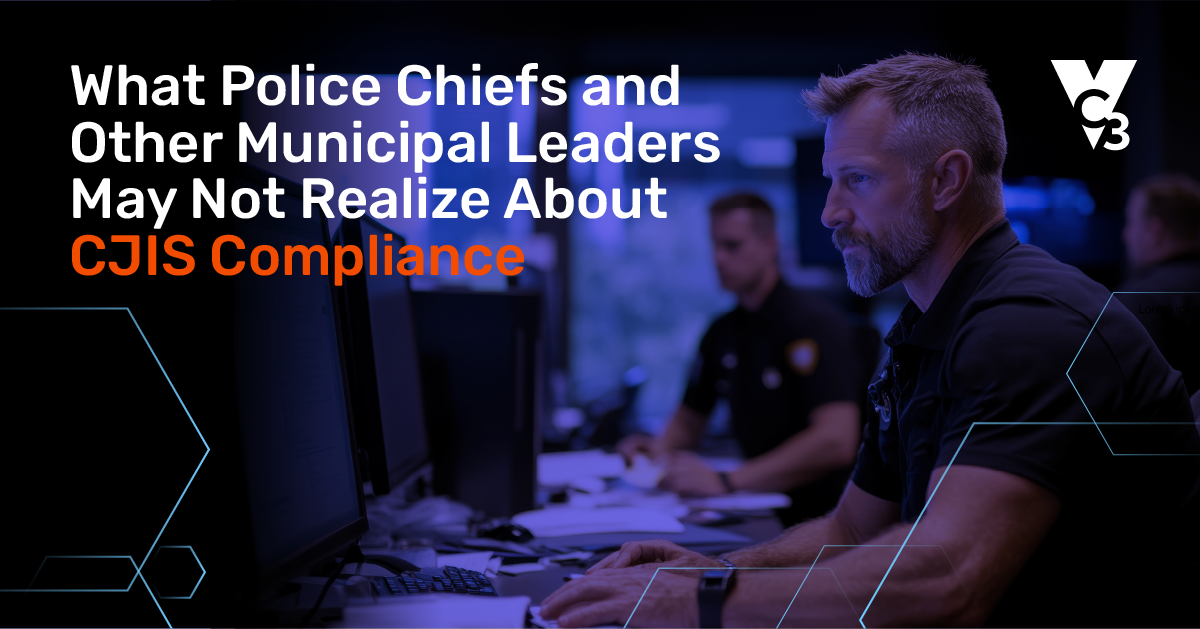When it comes to Criminal Justice Information Services (CJIS) compliance, many municipalities struggle—not because leaders don’t care but because responsibility often falls to a single, overworked IT employee with limited bandwidth. However, IT alone cannot meet the full set of CJIS requirements.
CJIS involves both technical and non-technical requirements. Compliance isn’t just about technology—it’s about your overall accountability protecting Criminal Justice Information (CJI) data, proving to auditors (and the public) that you take compliance seriously. But without clear lines of responsibility, critical tasks can fall through the cracks and even well-meaning teams risk noncompliance.
For police chiefs and municipal administrators, this responsibility is unavoidable. Auditors will look to leadership first, not IT, when critical policies or oversight steps are missing. This article breaks down CJIS requirements into clear responsibilities for leadership and IT, making it easier to delegate correctly, close gaps, and approach audits with confidence.
CJIS Compliance Control Families
Information Security Policy
You must have a written policy explaining how you protect CJI. This standard sets the foundation for CJIS compliance and gives auditors a benchmark to measure against.
|
Police Chief / Municipal Staff |
IT |
|
Create comprehensive security policies and procedures that align with CJIS requirements. |
Ensure secure transmission protocols are in place for any CJI data exchanges. |
|
Ensure agreements are signed and understood by all departments exchanging CJI (such as sharing with the DA’s office or other agencies). |
|
|
Conduct periodic reviews and updates to ensure policies remain current and effective. |
|
Security Awareness Training
Officers and staff in your department (and at your municipality if they handle CJI) must receive regular training on how to recognize common cybersecurity threats and protect sensitive information. Regular training prevents mistakes that technical tools can’t stop such as clicking on malicious links and attachments in a phishing email.
|
Police Chief / Municipal Staff |
IT |
|
Ensure that your personnel have completed any required CJIS security training. |
Conduct regular security awareness training for all employees. |
|
Maintain training records. |
Use phishing simulations to educate employees about email security threats. |
Incident Response
If you are hacked or your data is exposed, you need a documented plan that explains how you will respond. This ensures your agency can act quickly to contain issues and keep operating.
|
Police Chief / Municipal Staff |
IT |
|
Develop and maintain an incident response plan to address security incidents. |
Detect, log, respond to, and remediate incidents. |
|
Promptly report any security incidents or suspected breaches. |
Maintain incident response plans and tools. |
|
Ensure your team follows the documented incident response plan. |
|
|
Provide support for investigations. |
|
Auditing and Accountability
At core, this simply means you need to track who accesses CJI, and when. Logs prove compliance and help spot unusual activity early.
|
Police Chief / Municipal Staff |
IT |
|
Ensure that your staff follow access and usage rules. |
Maintain audit logs of access to CJI. |
|
Explain audit logs (such as anomalous employee access) during an audit, if necessary. |
Configure logging systems. |
|
|
Perform regular audits to review logs and ensure compliance with security policies. |
Access Control
Only authorized people should be able to access CJI, and they should only access what’s necessary to do their job. This reduces both misuse and accidental CJI exposure.
|
Police Chief / Municipal Staff |
IT |
|
Approve who should have access to CJI. |
Configure and manage technical access control systems (such as role permissions or user provisioning). |
|
Ensure role-based access is enforced. |
Ensure each user has a unique identifier for accessing systems. |
Identification and Authentication
Anyone accessing CJI must be uniquely identifiable, and you must be able to confirm they are who they say they are. Strong passwords and multifactor authentication (MFA) ensure access is limited to the right people.
|
Police Chief / Municipal Staff |
IT |
|
Ensure your staff follow policies around password creation and usage. |
Implement and enforce strong password policies. |
|
Enforce MFA compliance. |
Require MFA for accessing systems containing CJI. |
|
|
Monitor user authentication systems. |
Configuration Management
Configuration is technical, but this basically means that any IT systems must be set up securely and only changed through a controlled process (to prevent people from accidentally introducing weaknesses or purposely bypassing security measures). Documented configurations prevent errors and prove that changes are secure.
|
Police Chief / Municipal Staff |
IT |
|
[No role for you.]
|
Establish and maintain baseline configurations for systems handling CJI. |
|
|
Implement a change management process to control and document changes to systems. |
|
|
Update software securely. |
Media Protection
It’s easy to overlook USB drives, DVDs, and other storage media. Not only do they contain large amounts of sensitive data, but they are easy to lose or steal. They, too, must be protected (and disposed of) properly.
|
Police Chief / Municipal Staff |
IT |
|
Ensure removable media (such as USBs, DVDs, etc.) with CJI is protected and not misused. |
Encrypt and monitor CJI stored on physical media. |
|
|
Control ports and access permissions. |
|
|
Implement secure disposal methods for media containing CJI. |
Physical Protection
Whether through locks, surveillance, and other physical access safeguards, you need to protect CJI stored on and/or accessed on devices in your buildings and facilities. Physical safeguards ensure that only authorized personnel reach sensitive systems.
|
Police Chief / Municipal Staff |
IT |
|
Oversee physical security of facilities and systems handling CJI (such as locked server rooms or badge access). |
Advise on physical security requirements for IT systems. |
|
Use surveillance systems to monitor and protect physical access points. |
|
Systems and Communications Protection
Because cybercriminals often attempt to intercept or manipulate data in transit, you must technically make sure that IT systems are configured properly and data is protected as it moves through your IT network.
|
Police Chief / Municipal Staff |
IT |
|
Ensure the proper use of systems by staff. (For example, staff must avoid circumventing firewalls or using unauthorized tools). |
Deploy firewalls and intrusion detection/prevention systems to protect networks. |
|
|
Use secure communication protocols (such as TLS/SSL) for transmitting CJI. |
|
|
Maintain firewalls, endpoint detection and response (EDR), secure configurations, encryption, and network monitoring. |
Mobile Device and Remote Access
Just like you would secure desktop computers, you need to make sure laptops, phones, tablets, mobile devices, and any remote devices accessing CJI are secured. Mobile device management and encryption help keep remote access compliant.
|
Police Chief / Municipal Staff |
IT |
|
Enforce mobile device policies. (For example, no personal device use for CJI unless secured).
|
Manage MDM (mobile device management) solutions, encryption, and remote wipe capabilities. |
Personnel Security
Background checks and other vetting for anyone handling CJI is essential. Only trusted staff should access sensitive data, and access must be revoked immediately if roles change or employment ends.
|
Police Chief / Municipal Staff |
IT |
|
Conduct background checks on personnel with access to CJI.
|
Deactivate accounts as directed. |
|
Provide regular security training for all personnel handling CJI. |
Ensure access removal is prompt and secure. |
|
Terminate access upon job change or departure. |
|
Systems and Services Acquisition
Any vendors or cloud services that handle CJI must be CJIS-compliant or sign a CJIS Security Addendum. Adding CJIS requirements to contracts ensures compliance before new systems are adopted.
|
Police Chief / Municipal Staff |
IT |
|
Authorize purchases and approve IT systems in use. |
Ensure systems meet security requirements. |
|
Ensure procurement policies include language about vendor CJIS compliance. |
Document evidence of each vendor’s CJIS compliance. |
|
Ensure that any vendors (including cloud services vendors) that handle CJI are CJIS-compliant or they have signed a CJIS Security Addendum. |
Coordinate with vendors to confirm compliance or signed Addenda. |
|
|
Ensure integration of new systems into existing infrastructure to maintain security and compliance. |
Why Shared Responsibility Matters
While you’re likely not surprised by the list above, it may be a reminder that you’ve overlooked some critical areas where you need to oversee CJIS compliance activities. On average, an external IT resource can meet about 20-30% of your total CJIS requirements. The others are non-technical requirements that involve policy creation and management, training, oversight, and auditing documentation.
Audits often fail when responsibilities blur. A police chief assumes IT has it covered. IT assumes leadership has signed off. These are the types of gaps and miscommunication that lead to noncompliance.
Clear ownership of CJIS roles and responsibilities strengthens accountability and avoids misunderstandings. Only when both roles are clear does a complete CJIS compliance program take shape. When both municipal leaders and IT own their parts, agencies not only pass audits but also build lasting trust with stakeholders.
Moving Forward
By owning your role, you ensure smoother audits, stronger safeguards, and greater confidence from the public. Passing one audit is not enough. Compliance must become part of your daily operations. When policies are kept current, training is consistent, and technical safeguards are maintained, agencies reduce risk and show auditors that compliance is ongoing.
If your team needs support, partnering with experts who combine IT and compliance knowledge can lighten the load. With the right collaboration, CJIS compliance becomes standard practice, proving to your municipality, residents, and auditors that protecting CJI is a top priority.





